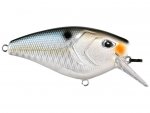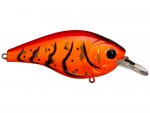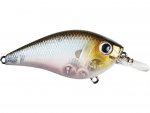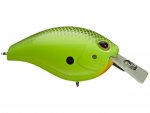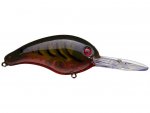King.Of.Anglers.Jeremiah
Fishing ? Instructor!
Alright everyone, it's a little late, but I'm beginning the breakdown of cranking today. This will be a general information guide to crankbait fishing and how to use them in the key time and places to maximize their effectiveness. Later I will do an advanced cranking thread and go in depth with specifics and some other information to take your crankbait fishing to the next level. Here, I will go over what makes a crankbait a crankbait for those who don't know and are just learning, then I will discuss profiles, colors, action, crankbait types, gear selection, crankbait applications, and then finally a few basic techniques to use. However, I will not talk about lipless crankbaits because they're fished completely different and I will later do a thread all about them. So, let's get into it, there's a LOT to talk about on this subject!
What exactly IS a crankbait?
Crankbaits are a family of lures made of varying materials ranging from wood, plastic, some metals and other materials, in every shape and size from barely an inch long for crappie, panfish and trout to some that are several inches long and are trolled for saltwater game fish like King mackerel, wahoo, tuna, and even gag grouper. The ones we are most familiar with as bass anglers are those ranging from about 2-4 inches in length and from about 1/4oz to just over 1oz. Most crankbaits come with a diving bill or "lip" at the front of the bait. Depending on the shape and size of the bait and the lip the bait when reeled or "cranked" back in will dive down to a set depth with roll, shimmy, tight wiggle or wide wobble on the retrieve.
Profiles: Crankbaits come in all kinds of shapes. Some are shaped like shad, some like sunfish, some like crawfish, and even turtles or frogs. Some don't look like anything in particular but just look like something good to eat. Which one you choose varies depending on time, location and available forage items in the water you are fishing. As a general rule, you should do what the fly fishermen call "match the hatch" which means matching your lure to the natural available food items the fish are feeding on as accurately as possible. For example, if I'm fishing a small backyard pond, I know my odds of catching bass on a bluegill or sunfish pattern bait are pretty high. If I'm on a large reservoir like Lanier, a shad or herring pattern may be a better option. If it's winter time or early spring and fish are sluggish from cold water temperature and they're close to the bottom, I'm throwing a crawfish pattern.
Colors: Crankbaits come in arguably just as many colors and combinations as soft plastic baits do. Generally the best one for the job depends on water clarity, though there are exceptions. Keep in mind that as a rule, spotted bass, shoal bass and smallmouth all prefer bright and gaudy colored crankbaits and jerkbaits and are easily fired up by florescent patterns even in clear water. There are definitely times when more natural patterns work better, but those species tend to be so aggressive that colors like hot pink, orange, yellow, and especially chartreuse get their attention. This is also especially true on smaller fish. Larger ones normally want more natural looking baits. On the other hand, the opposite is often true for largemouth in that they mostly have preference for natural looking colors and are turned off by anything bright and gaudy unless they are aggressively feeding at certain times like prespawn, or when the water clarity is very low and they can't see as well.
We're going to break down color selection into categories to keep things simple when you visit the bait shop or looking online. There are about 5 you should really pay attention to. "Ghost" patterns, Shad patterns, sunfish/bream patterns, attractor patterns, and crawfish patterns.
Ghost colors: Ghost patterns like "ghost minnow" or "ghost sexy shad" are colors that actually are mostly see-through or clear in color, but with subtle accents and details to complete the look. These come into play almost exclusively in clear water situations. There is not a better fit for those finicky bass in that deep, rocky reservoir than a ghost pattern jerkbait or crankbait especially if clarity is beyond 5ft in depth.
Shad Patterns: these colors are self explanatory, as they look like any shad or herring. There are multiple variations, but these tend to be more opaque in color. Many of these feature a lot of white on them. Colors like "threadfin shad" or "sexy shad" or anything shiny or even chrome imitates a shad or herring extremely well. These come into play on lakes with high populations of shad or herring. Especially when bass are schooling.
Sunfish/Bream patterns: These look like any member of the sunfish family and imitate anything from bluegill to pumpkinseeds, green sunfish, redear sunfish and even crappies. They're great choices when the water is relatively clear or slightly stained and there isn't an abundance of shad or herring available. Great for ponds, creeks, small lakes and small sections of Rivers.
Crawfish patterns: There are dozens of crawfish patterns and they come in as many colors as crawfish do themselves. There are many craw patterns, the most popular of which arguably is the red craw pattern. These grew quite the reputation out in Texas on early spring bass so much so that "Texas craw" or "Texas red" became it's own color pattern. Early in the spring, a red crankbait is hard to beat wherever you live. Still though, when it comes to craw patterns, you can't go wrong with any green or brown craw pattern you find, as well as those with a little black on them. One highly successful crawfish crankbait, the rebel craw series, is actually shaped like a crawfish, and comes in several craw colors. Use crawfish crankbaits around any rocky cover where crawfish are known to live or any time fish aren't active and chasing baitfish. They're also great in streams and rivers.
Attractor patterns: These are those bright colored baits in hot orange, Chartreuse, electric blue, yellow, hot pink and other bright colors. They're best suited for dirty water or really aggressive fish. Blue over chartreuse is a known deadly pattern on smallmouth and spotted bass. Black over Chartreuse is a killer for largemouth in muddy or heavily stained water. These bright colors often work well for many other species too. Hot pink is great for not only smallmouth but also a known steelhead catcher. Orange and Chartreuse works well on musky and walleye. Crappies like a bright yellow too, and striper will smash a bright white or chartreuse and white so don't be surprised if you have some by catch while bass fishing with bright lures. But again, as a general rule, largemouth are only interested in these colors when the water is dirty. Reason being is that they can see it. Bass feed mostly by sight and a bright color helps them to find it.
Bonus category - Soft plastic colors: I was going to save this for the advanced cranking course, but a somewhat new thing companies are doing is making crankbaits in traditional soft plastic patterns now. You can find a "watermelon red" or "green pumpkin" or even "Junebug" crankbait now. They have a tendency to be better in clear water as they look more natural but they're a nice choice because it's something the fish often times have never seen before.
That's it for part one of this post, next I will go into different types of crankbaits and their applications, and then I will go into gear selection. When I finish, we'll discuss techniques for each type and locations to use them.
What exactly IS a crankbait?
Crankbaits are a family of lures made of varying materials ranging from wood, plastic, some metals and other materials, in every shape and size from barely an inch long for crappie, panfish and trout to some that are several inches long and are trolled for saltwater game fish like King mackerel, wahoo, tuna, and even gag grouper. The ones we are most familiar with as bass anglers are those ranging from about 2-4 inches in length and from about 1/4oz to just over 1oz. Most crankbaits come with a diving bill or "lip" at the front of the bait. Depending on the shape and size of the bait and the lip the bait when reeled or "cranked" back in will dive down to a set depth with roll, shimmy, tight wiggle or wide wobble on the retrieve.
Profiles: Crankbaits come in all kinds of shapes. Some are shaped like shad, some like sunfish, some like crawfish, and even turtles or frogs. Some don't look like anything in particular but just look like something good to eat. Which one you choose varies depending on time, location and available forage items in the water you are fishing. As a general rule, you should do what the fly fishermen call "match the hatch" which means matching your lure to the natural available food items the fish are feeding on as accurately as possible. For example, if I'm fishing a small backyard pond, I know my odds of catching bass on a bluegill or sunfish pattern bait are pretty high. If I'm on a large reservoir like Lanier, a shad or herring pattern may be a better option. If it's winter time or early spring and fish are sluggish from cold water temperature and they're close to the bottom, I'm throwing a crawfish pattern.
Colors: Crankbaits come in arguably just as many colors and combinations as soft plastic baits do. Generally the best one for the job depends on water clarity, though there are exceptions. Keep in mind that as a rule, spotted bass, shoal bass and smallmouth all prefer bright and gaudy colored crankbaits and jerkbaits and are easily fired up by florescent patterns even in clear water. There are definitely times when more natural patterns work better, but those species tend to be so aggressive that colors like hot pink, orange, yellow, and especially chartreuse get their attention. This is also especially true on smaller fish. Larger ones normally want more natural looking baits. On the other hand, the opposite is often true for largemouth in that they mostly have preference for natural looking colors and are turned off by anything bright and gaudy unless they are aggressively feeding at certain times like prespawn, or when the water clarity is very low and they can't see as well.
We're going to break down color selection into categories to keep things simple when you visit the bait shop or looking online. There are about 5 you should really pay attention to. "Ghost" patterns, Shad patterns, sunfish/bream patterns, attractor patterns, and crawfish patterns.
Ghost colors: Ghost patterns like "ghost minnow" or "ghost sexy shad" are colors that actually are mostly see-through or clear in color, but with subtle accents and details to complete the look. These come into play almost exclusively in clear water situations. There is not a better fit for those finicky bass in that deep, rocky reservoir than a ghost pattern jerkbait or crankbait especially if clarity is beyond 5ft in depth.
Shad Patterns: these colors are self explanatory, as they look like any shad or herring. There are multiple variations, but these tend to be more opaque in color. Many of these feature a lot of white on them. Colors like "threadfin shad" or "sexy shad" or anything shiny or even chrome imitates a shad or herring extremely well. These come into play on lakes with high populations of shad or herring. Especially when bass are schooling.
Sunfish/Bream patterns: These look like any member of the sunfish family and imitate anything from bluegill to pumpkinseeds, green sunfish, redear sunfish and even crappies. They're great choices when the water is relatively clear or slightly stained and there isn't an abundance of shad or herring available. Great for ponds, creeks, small lakes and small sections of Rivers.
Crawfish patterns: There are dozens of crawfish patterns and they come in as many colors as crawfish do themselves. There are many craw patterns, the most popular of which arguably is the red craw pattern. These grew quite the reputation out in Texas on early spring bass so much so that "Texas craw" or "Texas red" became it's own color pattern. Early in the spring, a red crankbait is hard to beat wherever you live. Still though, when it comes to craw patterns, you can't go wrong with any green or brown craw pattern you find, as well as those with a little black on them. One highly successful crawfish crankbait, the rebel craw series, is actually shaped like a crawfish, and comes in several craw colors. Use crawfish crankbaits around any rocky cover where crawfish are known to live or any time fish aren't active and chasing baitfish. They're also great in streams and rivers.
Attractor patterns: These are those bright colored baits in hot orange, Chartreuse, electric blue, yellow, hot pink and other bright colors. They're best suited for dirty water or really aggressive fish. Blue over chartreuse is a known deadly pattern on smallmouth and spotted bass. Black over Chartreuse is a killer for largemouth in muddy or heavily stained water. These bright colors often work well for many other species too. Hot pink is great for not only smallmouth but also a known steelhead catcher. Orange and Chartreuse works well on musky and walleye. Crappies like a bright yellow too, and striper will smash a bright white or chartreuse and white so don't be surprised if you have some by catch while bass fishing with bright lures. But again, as a general rule, largemouth are only interested in these colors when the water is dirty. Reason being is that they can see it. Bass feed mostly by sight and a bright color helps them to find it.
Bonus category - Soft plastic colors: I was going to save this for the advanced cranking course, but a somewhat new thing companies are doing is making crankbaits in traditional soft plastic patterns now. You can find a "watermelon red" or "green pumpkin" or even "Junebug" crankbait now. They have a tendency to be better in clear water as they look more natural but they're a nice choice because it's something the fish often times have never seen before.
That's it for part one of this post, next I will go into different types of crankbaits and their applications, and then I will go into gear selection. When I finish, we'll discuss techniques for each type and locations to use them.

